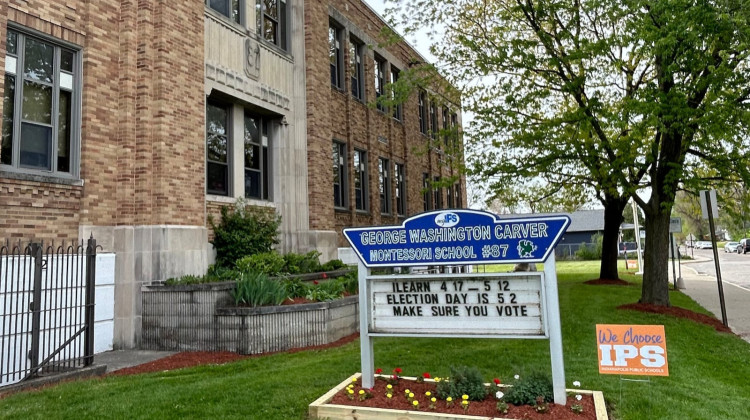WEST LAFAYETTE, Ind. (AP) — A new paint developed by researchers at Purdue University is the coolest — literally.
When Xiulin Ruan, a professor of mechanical engineering at the school, and his graduate students began working on this project seven years ago, they didn’t set out to invent a new paint color. Rather, they wanted to find a way to conserve energy and fight climate change. But what they found is that paint could do just that.
And so Ruan and his team created the world’s whitest paint — a title it recently earned in the Guinness World Records book, a never achieved status.
This paint, however, can do much more than set world records. It is considered a breakthrough in sustainability, one that could reduce or even eliminate the need for air conditioning, and thus the energy needed to power it.
“The impact of this paint, it’s good for trying to alleviate global warming, the urban heat island effect and the electricity crisis,” said Xiangyu Li, a postdoctoral researcher at the Massachusetts Institute of Technology who worked on this project as a Ph.D. student in Ruan’s lab. “But the part I like the best is that it could directly impact peoples’ electricity bills, and that’s something everyone can relate to.”
Developing the formula for this paint wasn’t easy. The multiple-year study builds on efforts to create a cooling paint as an alternative to traditional air conditioning that dates back to the 1970s.
The researchers considered over 100 different materials and narrowed their options down to 10. From there, the lab tested about 50 different formulations for each material.
“I started looking at every white material in my daily life,” Li said.
That’s when they found barium sulfate. The paint is based on two key features: the concentration and size of the barium sulfate compound.
The paint has a very high concentration of the compound, which is also used to make photo paper and cosmetics white. It also has particles of the barium sulfate that are of all different sizes in the paint.
Most white paints have one single particle size that reflects the visible portion of the solar spectrum, but they absorb more ultraviolet and infrared light, according to Joseph Peoples, a Ph.D. candidate in Purdue’s School of Mechanical Engineering who also worked in Ruan’s lab.
“The largest difficulty was making the paint as reflective as possible for the entire solar spectrum,” Peoples said.
The amount of light each barium sulfate particle scatters depends on its size, Peoples said. So having a wider range of particle sizes allows the paint to scatter more of the full light spectrum.
The researchers think that this whitest white paint is likely the closest equivalent to Vantablack, the blackest black paint that absorbs up to 99.9% of visible light. The paint that Ruan’s lab landed on reflects up to 98.1% of sunlight, according to the research. This compares to the other highly reflective paints on the market that reflect between 80 to 90% of light.
Because Ruan’s paint reflects almost all incoming sunlight, it’s not taking on any energy. Then it goes a step further, emitting thermal energy into outer-space beyond Earth’s atmosphere, meaning it sends out more heat than it takes in.
“Let’s say it is a dry sunny day outside and the temperature is 85 degrees Fahrenheit,” a surface covered with the paint from Purdue “will be around 75 degrees Fahrenheit,” Peoples said. “The paint cools itself below ambient, creating free refrigeration, with no electricity input at all.”
By lowering the surface temperatures of buildings painted with this white paint, it also lowers the inside temperatures of said buildings. If buildings aren’t heating up from sunlight, then that lowers the need to switch on their air conditioning as high or removes it entirely.
“If you were to use this paint to cover a roof area of about 1,000 square feet, we estimate that you could get a cooling power of 10 kilowatts,” Ruan said in a statement. “That’s more powerful than the central air conditioners used by most houses.”
Ruan is working to bring the paint to market and therefore his schedule did not allow him to speak with IndyStar.
While the difference of 98% to 90% might not seem like a lot, Li said that before a building was absorbing 10% of sunlight and now it’s only absorbing 2% – “so it’s actually absorbing five times less, which gives major cooling benefits.”
When most people think of cutting back on carbon emissions, their thoughts go to the transportation sector and industry. Buildings, however, generate nearly 40% of annual energy-related CO2 emissions across the world, according to the United Nations climate report. In Indianapolis, 66% of community-wide greenhouse gas emissions come from buildings, the city said. The majority of those emissions are the result of building operations such as cooling and heating.
Therefore, cutting down on cooling means using less energy produced by fossil fuels such as coal and natural gas, which could lead to reduced climate change-causing carbon emissions.
“I think the white paint discovery has, over the longer term, potentially some big implications,” said Jeff Dukes, the executive director of the Purdue Climate Change Research Center. “In many parts of the world where we want to be cooling our buildings for most of or all of the year for comfortable spaces, this could mean big potential energy savings.”
The whitest paint also can help reduce the urban heat island effect, according to Peoples. Urban heat islands are the result of cities replacing natural land cover with pavement, buildings and other materials that absorb and retain heat. That increases energy needs, pollution levels and heat related illnesses.
Climate change is causing more frequent and severe heat waves. According to research out of Dukes’ center, Indiana could see as much as 30 more days above 95 degrees by mid-century.
The recent UN climate change report issued a “code red for humanity” when it comes to the climate crisis, and stressed the importance of taking rapid action to curb emissions. This paint could be just one tool in that toolbox, Dukes said.
For the everyday American, the paint also could make a big difference for their pockets, Li said, because it’s essentially creating free air conditioning.
For a one-story house of about 1,000 square feet, the paint could save about a dollar a day that would have been spent on air conditioning. That comes out to about $30 a month or nearly $360 in a year in electricity cost savings.
“The paint has the benefits of saving on electric bills and at the same time contributing to saving the earth,” Li said, “it connects with everyone.”
This paint could be used in multiple ways, according to the researchers. The most obvious is on commercial as well as residential buildings, both on their roofs, which face direct sunlight, and the side walls.
But the researchers add that it could even go as far as being applied to road surfaces or cars to help cool the earth’s surface on an even larger scale.
The team has filed a patent application for the paint and it is currently going through necessary testing to bring it to market on a large scale. Ruan and his lab are working with a commercial company to ensure that the paint meets the reliability requirements of outdoor paints and is able to withstand the elements.
There is no timeline for when the paint will hit store shelves, Li said, but it likely will be a couple years before customers can buy it at their local hardware store. The paint from Purdue should be cost competitive with other outdoor paints, he added, and use a similar fabrication process so it is not difficult to produce.
“Our goal is that if we can push it to the market, it will be like buying any other white paint,” Li said. “The most important way we can make the most of scientific innovation in this field is to make it so that more and more people can use it.”
That’s why Ruan and his graduate students loved the idea of a paint: It’s approachable and easy.
Still, they recognize that there will be some challenges in getting folks to adopt and use the white paint. Especially from a residential perspective, many homeowners might not be used to seeing white walls or they might want their house to stand out from others on their street.
“Already people aren’t using white paint everywhere to try to keep buildings cool,” Dukes said, “so it’s a question of how many people are going to use it?”
The city of Indianapolis said it had ideas on how it can increase adoption of such practices. The Sustainability Office is always looking at how to better utilize incentives that it can leverage and encourage residents to use these types of materials, office executive director Morgan Mickelson said.
City officials also recently enacted a Benchmarking and Transparency Ordinance to help improve the energy and water efficiency of Indianapolis buildings. For building owners that participate in the program, they must measure how their buildings use water and energy every year and then report it annually. With that data, they can then work with the city to find ways to make reductions.
Mickelson said she thinks this paint, when available, could be one key way to do that.
“Our built environment has one of the largest opportunities for reducing greenhouse gas emissions significantly,” she said, adding that the city will try to find ways to use this paint on its own buildings when it’s available.
“To have the whitest white paint from Purdue University is so exciting,” Mickelson added, “especially to be an Indiana institution leading the charge on this type of work.”
 DONATE
DONATE







 Support WFYI. We can't do it without you.
Support WFYI. We can't do it without you.